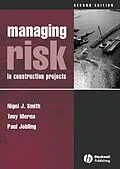Written by a group of academics and practitioners, this guide is
for construction practitioners having to manage real projects. It
shows how the risk management process improves decision making in
conditions of uncertainty.
This new edition includes the input of the Turnbull report, as
well as to introduce the concept of corporate, strategic business,
and project level risk.
The authors cover:
* a description of risk management and decision making in the
context of a construction project
* the human dimension
* tools and techniques available to the risk analyst
* the problems of procurement and finance
* the practical application of risk analysis, including the
principles of risk modelling and simulation, together wit case
studies
A thorough understanding of these concepts will provide the
project manager with the basis for effective decision making.
From the reviews of the first edition:
"This book should be compulsory reading for all concerned with
the management of risk in construction - whether academics or
practitioners."
--Chartered Surveyor Monthly
"A valuable addition to the literature ... which helps condense,
simplify and provide practical advice on how to implement risk
management on construction projects."
Autorentext
Nigel Smith is Professor of Transport Infrastructure &
Project Management at the School of Civil Engineering, University
of Leeds.
Tony Merna is a lecturer in Civil & Construction
Engineering, School of Mechanical, Aerospace and Civil
Engineering., University of Manchester.
Paul Jobling is a Senior Professional Associate and
Project Director Risk Management at Parsons Brinckerhoff.
Zusammenfassung
Written by a group of academics and practitioners, this guide is for construction practitioners having to manage real projects. It shows how the risk management process improves decision making in conditions of uncertainty.
This new edition includes the input of the Turnbull report, as well as to introduce the concept of corporate, strategic business, and project level risk.
The authors cover:
- a description of risk management and decision making in the context of a construction project
- the human dimension
- tools and techniques available to the risk analyst
- the problems of procurement and finance
- the practical application of risk analysis, including the principles of risk modelling and simulation, together wit case studies
A thorough understanding of these concepts will provide the project manager with the basis for effective decision making.
From the reviews of the first edition:
"This book should be compulsory reading for all concerned with the management of risk in construction whether academics or practitioners."
Chartered Surveyor Monthly
"A valuable addition to the literature ... which helps condense, simplify and provide practical advice on how to implement risk management on construction projects."
Inhalt
1. PROJECTS AND RISK.
1.1 Engineering Projects.
1.2 Decision Making.
1.3 Risk Management Strategy.
1.4 Project Planning.
1.5 Summary.
2. THE PROJECT ENVIRONMENT.
2.1 Projects.
2.2 The Project Constitution.
2.3 Project Organisation.
2.4 Project Phases.
2.5 Effects of Project Phase on Risk.
2.6 Project Appraisal.
2.7 Summary.
3. UNDERSTANDING THE HUMAN ASPECTS.
3.1 Risk Management - People.
3.2 Risk Management - Organisations.
3.3 The Risk Management Process.
3.4 Some Guidelines to the Risk Management Process.
3.5 Preparing a Group for a Risk Session - Risk
Identification.
3.6 Communication.
3.7 Summary.
4. RISK AND VALUE MANAGEMENT.
4.1 Introduction.
4.2 The Standard Risk Management Model.
4.3 Apply Risk and Value Management.
4.4 Value Management Processes.
4.5 Understanding the Project Risk.
4.6 Applying Value and Risk Management.
4.7 Iteration of the Process.
4.8 Summary.
5. QUALITATIVE METHODS AND SOFT SYSTEMS METHODOLOGY.
5.1 Qualitative Risk Assessment.
5.2 Review of Project Programmes and Budgets.
5.3 The Risk Log.
5.4 Using a Risk Log to Formulate Risk Management Strategy.
5.5 Qualitative Methodologies.
5.6 Soft Systems Methodology.
5.7 Case Study.
5.8 Summary.
6. QUANTITATIVE METHODS FOR RISK MANAGEMENT.
6.1 Sanction.
6.2 Project Appraisal and Selection.
6.3 Project Evaluation.
6.4 Engineering Risks.
6.5 Risk Management.
6.6 Probabilistic Analysis.
6.7 Response to Risks.
6.8 Successful Risk Management.
Annex.
